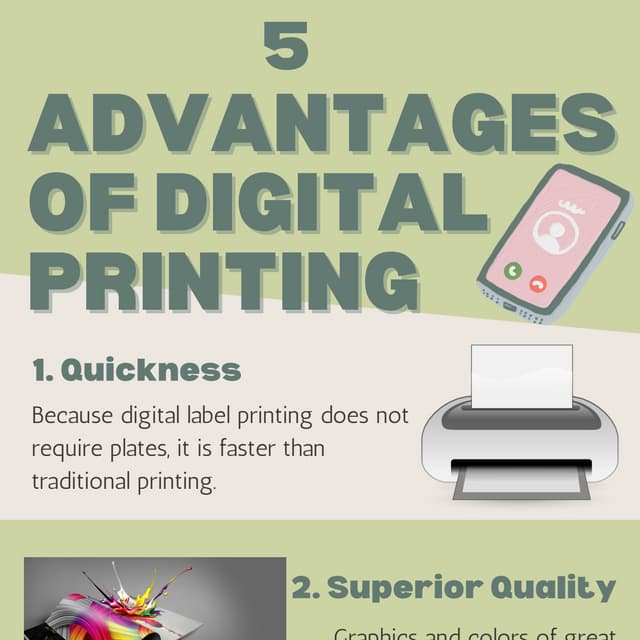The Ultimate Guide To Digital Printing
The Ultimate Guide To Digital Printing
Blog Article
The Ultimate Guide To Digital Printing
Table of ContentsDigital Printing - The FactsThe Definitive Guide for Digital PrintingDigital Printing Fundamentals ExplainedDigital Printing - QuestionsAbout Digital PrintingThe Best Guide To Digital Printing
Variable data printing, such as direct mail with customized codes and addresses, is ideally fit for digital printing. Digital quick printing just requires 4 actions of design, testimonial, printing and binding to obtain everything done. Digital quick printing has an unmatched benefit: print on need.According to PMMI, digital printing permits brands and manufacturers to respond quickly to client demands while boosting the supply chain, decreasing warehousing expense and waste, and taking pleasure in faster time to market. That all audios great, but just how does this technology do all that? The major differentiator of these technologies is that there are no set up costs and no plates with digital printing.
Excitement About Digital Printing
This results in quicker turn-around time and reduces price when using digital printing.
Fast production means obtaining your item to market faster. It likewise means it's much easier and faster to make adjustments in the future, when you transform a recipe, add a SKU, or produce seasonal packaging. Digital printing is highly versatile, so it's very easy to make adjustments to the package design promptly. It all goes back to the plates.
More supply can imply even more waste later on. With standard printing approaches, short-run printing is simply not feasible. Because a great design can make or break your item, digital printing consistently creates high-grade, clear and vibrant graphics each time. Digital printing on flexible pouches includes the brilliant, dynamic, and specific graphics that almost beckon consumers to connect and touch them.
Digital printing is the procedure of printing digital-based photos directly onto a selection of media substratums. There is no demand for a printing plate, unlike with countered printing. Digital documents such as PDFs or desktop computer posting data can be sent directly to the digital printing machine to print on paper, picture paper, canvas, material, synthetics, cardstock and other substrates.
Little Known Facts About Digital Printing.
According to PMMI, digital printing enables brand names and producers to react swiftly to client demands while enhancing the supply chain, decreasing warehousing expense and waste, and delighting in faster time to market. That all audios fantastic, but just how does this innovation do all that? The significant differentiator of these innovations is that there are no set-up fees and no plates with digital printing.
According to Wikipedia, the biggest distinction between electronic printing and conventional methods such as lithography, flexography, top article gravure, or letterpress is that there is no need to replace printing plates in electronic printing, whereas in these analog printing techniques home plates are consistently changed. This leads to quicker turnaround time and decreases expense when making use of digital printing.

Digital Printing Can Be Fun For Anyone
With traditional printing approaches, short-run printing is just not possible. Because a wonderful style can make or break your item, digital printing continually develops top notch, clear and colorful graphics each time.

According to PMMI, digital printing permits brands and suppliers to react quickly to client demands while enhancing the supply chain, decreasing warehousing price and waste, and appreciating faster time to market. That all noises terrific, yet just how does this innovation do all that? their explanation The significant differentiator of these modern technologies is that there are no set-up fees and no plates with digital printing.
A Biased View of Digital Printing
According to Wikipedia, the best difference in between electronic printing and standard approaches such as lithography, flexography, gravure, or letterpress is that there is no demand to replace printing plates in digital printing, whereas in these analog printing methods the plates are consistently changed. This leads to quicker turn-around time and decreases price when utilizing digital printing.
Rapid production suggests obtaining your product to market quicker. It additionally indicates it's simpler and faster to make changes later, when you transform a dish, add a SKU, or create seasonal packaging. Digital printing is extremely adaptable, so it's very easy to make changes to the package style quickly. All of it returns to home plates.

The Buzz on Digital Printing
Digital printing is the procedure of printing digital-based photos straight onto a variety of media substratums. There is no demand for a printing plate, unlike with countered printing. Digital data such as PDFs or desktop computer posting data can be sent out directly to the digital printing machine to print theoretically, photo paper, canvas, fabric, synthetics, cardstock and other substratums.
Report this page